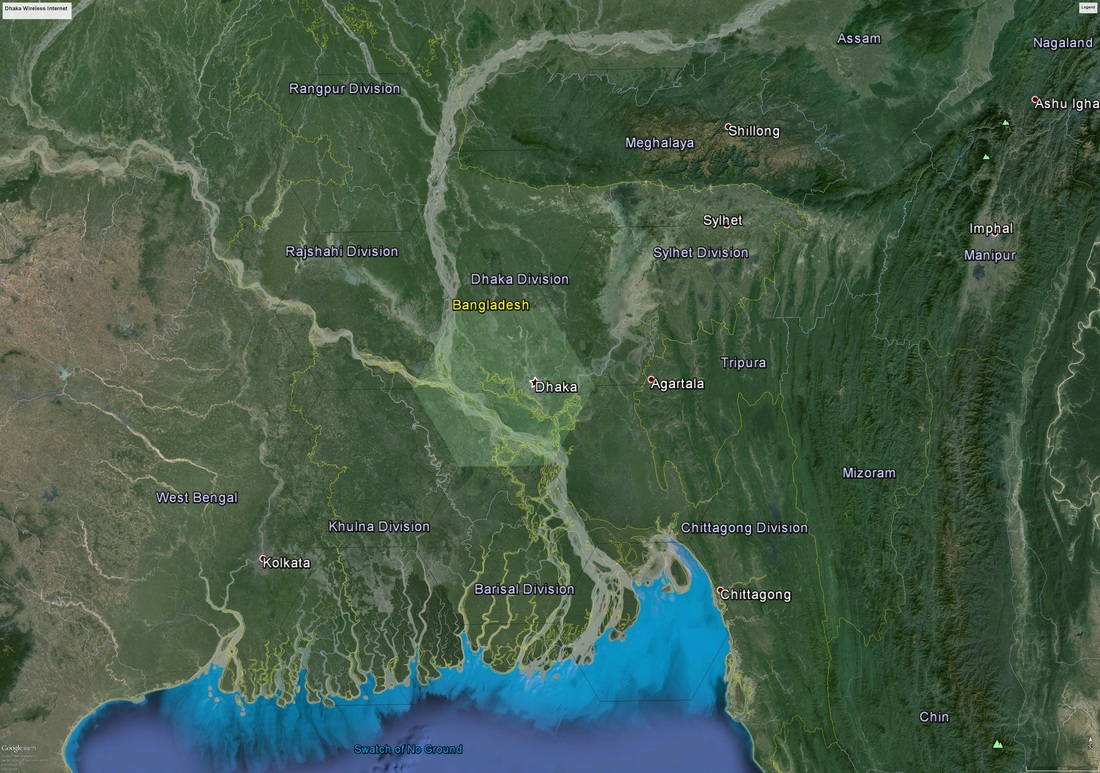|
Google and Facebook have raised awareness of alternative strategies to get Internet service to the other three billion (O3B) without internet access in the developing world. Their motivations are not altruistic. The O3B are their future customers. Google is pursuing balloons with the Loon project, high altitude drones with its purchase of Titan, and satellites with its announcement that it plans to deploy a constellation of 180 medium earth orbit satellites. Facebook has announced it is deploying satellites and purchased Ascenta, a drone company.
A quick look at internet statistics shows that the majority of those without an Internet connection are in Asia, about 2.8 Billion. A look at land areas in the countries that account for the bulk of the market shows that population densities are very high. This combination requires a high total bandwidth over relatively small land areas. We call this a high bandwidth density solution. Current and proposed satellite solutions can only provide low bandwidth density. Similarly Google Loon and high altitude drones have very small payloads and can only provide low bandwidth density. All these technologies are years from deployment and have difficulty with a low $1.00/month price. We propose a high bandwidth density StratoSolar platform wireless Internet solution using stratospheric permanently tethered platforms. A platform tethered at 20km altitude can provide reliable wireless internet service to a radius of about 75km, which is an area of about 15,000km2. For the population density in Asia, a wireless internet platform solution covering an area of 15,000km2 needs to provide enough bandwidth for from about 1,000,000 to 8,000,000 customers, or up to a total of about one terabit per second for broadband access. A crude analysis to scope the problem yields a platform count of about 1,100 for Asia. In most cases there are low population density areas that would be best served with low bandwidth density solutions like satellites, so the number of platforms would be less (perhaps 600). This is especially true for China. There would also be very high bandwidth density areas in urban cores where the wireless platform bandwidth density would be insufficient to satisfy the entire market. We propose a quickly deploy-able solution based on existing hardware and software currently being used by the rapidly growing wireless internet service provider (WISP) market that uses the unlicensed radio bands. As is currently done with satellites we propose to provide very large overall bandwidth by using many spot beams with massive frequency re-use. The solution can be thought of as a WISP with a very tall tower that supports a lot of antenna. With highly directional antenna at both the platform and the customer the link budgets are conservative and the interference requirements of the unlicensed bands can be met. We would envisage from about 271 to 1000 cells per platform, providing broadband Internet access to from 1,000,000 to 8,000,000 customers. The aggregate cell throughput exceeds 1Gb/s. The large payload, large antenna support structure area, and large continuous PV power with gravity energy storage provided by the platform are what enable the rapid deployment of this platform composed largely of off the shelf wireless internet and internet switch hardware. The off the shelf wireless hardware and the antenna are not designed for miniaturization and weigh several tonnes and consume several kW of power. The major impediment to deployment is political. Each country will be different. The only physical problem is the hazard that tethers pose to aviation, which can be handled by the airspace regulator of each country. Commercial aviation in Asia is very small and general aviation is almost non-existent compared to the US and Europe. The politics of communications infrastructure are harder to gauge. China may be a non starter. The initial goal is to get one country to deploy one platform. The economics are very favorable and would provide internet service at prices that most households in Asia could afford . If the average platform has 4,000,000 customers at $1:00/month, that is $48M/year income for a platform that costs about $4M including the wireless hardware. Customer premises equipment (CPE) would be about $25 or less per customer. $25 is a lot of money in large parts of the target market, so reducing CPE costs and methods of financing CPE are important. From an individual countries perspective, internet service deployment can occur without much investment and in a timeframe dictated mostly by customers. High altitude platforms will deploy in less than a week once airspace is approved. Coverage for a country could be deployed in less than a year. Initially a backbone internet could be provided with wireless or FSO links between platforms. Once a platform is deployed customers can buy or rent CPE and be on the internet immediately. They will need electricity, but that might come from a PV panel and a battery in an isolated area. A local wireless base station could provide Wi-Fi internet to a village. By Edmund Kelly
Comments
|
Archives
December 2023
Categories
All
|
|
© 2024 StratoSolar Inc. All rights reserved.
|
Contact Us
|



 RSS Feed
RSS Feed